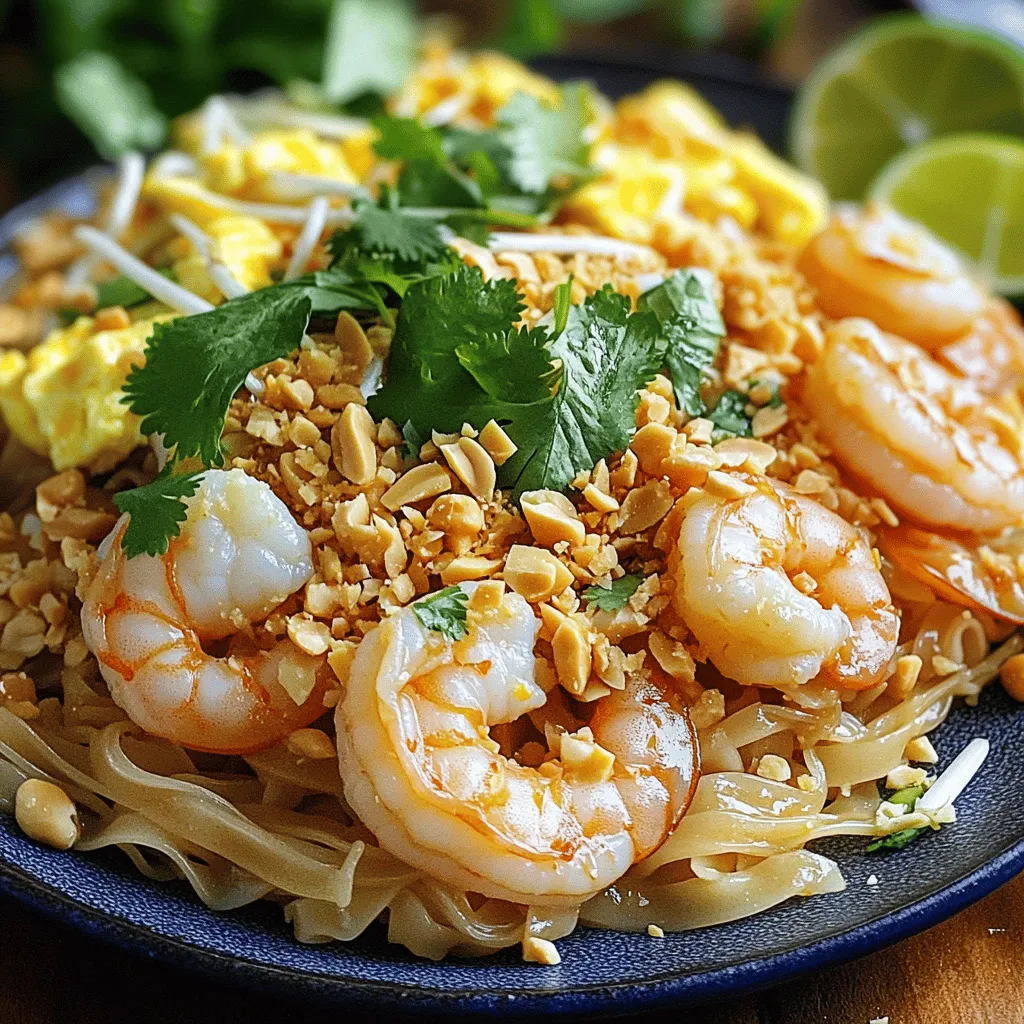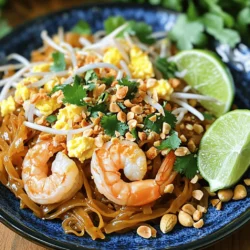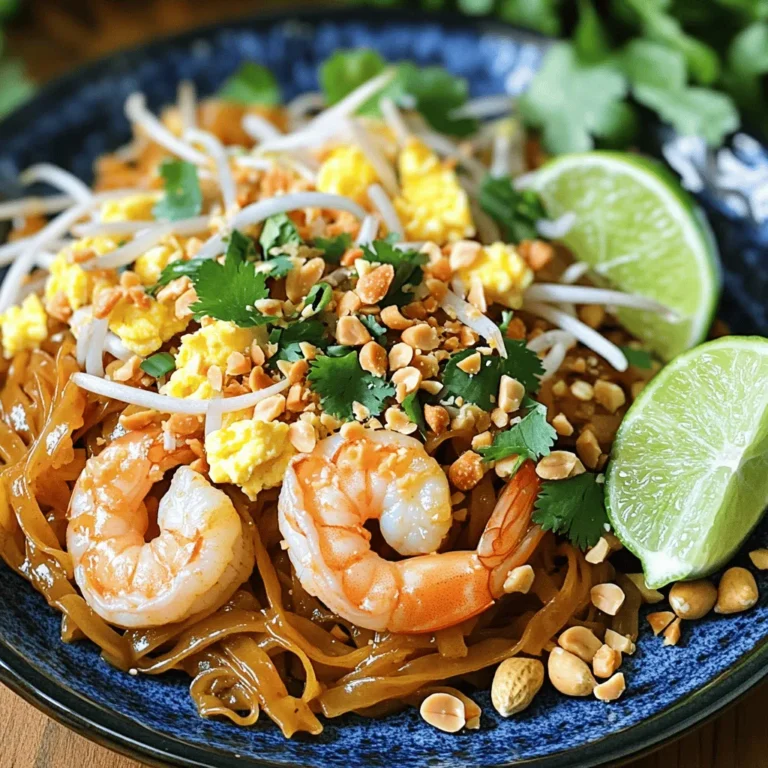Craving a delicious meal that’s easy to make at home? Look no further! In this post, I’ll guide you through an Easy Pad Thai recipe that bursts with flavor. You’ll learn to make this classic dish with simple ingredients and clear steps. Whether you’re a busy cook or a food newbie, this tasty treat is perfect for you. Let’s dive into the world of Pad Thai together!It uses fresh ingredients for a tasty meal. You can prepare it in about 25 minutes.
Detailed Ingredients List
– 8 oz flat rice noodles
– 2 tablespoons vegetable oil
– 2 cloves garlic, minced
– 1 cup shrimp (or tofu)
– 2 eggs, lightly beaten
– 1 cup bean sprouts
– 1/2 cup green onions, sliced
– 1/4 cup crushed peanuts
– 3 tablespoons fish sauce (or soy sauce)
– 2 tablespoons tamarind paste
– 1 tablespoon brown sugar
– Lime wedges and fresh cilantro for garnish
Each ingredient plays a key role. The flat rice noodles provide a soft base. The shrimp or tofu adds protein. Garlic gives a strong flavor. The bean sprouts and green onions add crunch and freshness.
Fish sauce or soy sauce brings saltiness to the dish. Tamarind paste offers a sweet and sour taste. Brown sugar balances the flavors well. Finally, crushed peanuts and lime wedges add a nice touch for serving.
Use fresh vegetables and proteins for the best taste. This Pad Thai is fun to make and share!
Step-by-Step Instructions
Cooking the Noodles
First, boil water in a big pot. Add the flat rice noodles once the water boils. Cook them according to the package instructions. This usually takes about 5-7 minutes. Once soft, drain the noodles and set them aside. It’s important not to overcook them, as they will stick together later.
Preparing the Protein
Next, heat vegetable oil in a large pan or wok over medium-high heat. Add minced garlic and cook for about 30 seconds. This step makes the kitchen smell amazing! Then, add shrimp or tofu to the pan. Cook for about 2-3 minutes until they are fully cooked. If using shrimp, it will turn pink. Once cooked, push everything to one side of the pan.
Then, pour the beaten eggs into the empty side of the pan. Scramble them until just set. Once they’re cooked, mix the eggs with the shrimp or tofu. This adds protein and flavor to your dish.
Combining Ingredients and Serving
Now, it’s time to bring it all together. Add the cooked rice noodles into the pan. Pour in the fish sauce, tamarind paste, and brown sugar. Toss everything together to coat the noodles well. The sauce gives the Pad Thai its signature taste.
Then, add the bean sprouts and green onions. Stir-fry for 2-3 more minutes until everything is hot. Remove from heat and taste your dish. Adjust the seasoning if you want it saltier or sweeter.
Serve your Easy Pad Thai hot. Garnish with crushed peanuts, fresh cilantro, and lime wedges. This adds a nice crunch and fresh flavor.
Tips & Tricks
Achieving Perfect Noodles
To get the best noodles, always follow the package instructions. Soak the flat rice noodles in hot water until they are soft. This usually takes about 10 minutes. After soaking, drain them well. Do not overcook them, or they will turn mushy. A quick toss in the pan will keep them firm and chewy.
Enhancing Flavor
Flavor is key in Pad Thai. Use fresh garlic for a great taste. Fish sauce or soy sauce adds a savory edge. Tamarind paste gives that unique sour note. Balance these flavors with a bit of brown sugar. You can taste and adjust as you cook. If you want more spice, add chili flakes or fresh peppers while cooking.
Customizing for Dietary Needs
You can easily make this dish fit your needs. For a vegetarian option, swap shrimp for tofu. Use soy sauce instead of fish sauce. Want it gluten-free? Choose gluten-free soy sauce. Add more veggies, like bell peppers or carrots, for extra crunch. You can make it your own while still keeping it delicious!

Variations
Vegetarian Pad Thai Options
You can make a tasty vegetarian Pad Thai easily. Just swap shrimp for tofu. Tofu soaks up flavors well. Use firm tofu for the best texture. You can also add more veggies. Try bell peppers, carrots, or broccoli. They add crunch and color. Use soy sauce instead of fish sauce. This keeps it plant-based and still tasty.
Protein Alternatives
Beyond shrimp and tofu, you have choices. Chicken or beef can work great too. Slice them thin for fast cooking. Keep in mind that different proteins change the taste. Each choice brings its own twist. You can even use tempeh or seitan for a unique flavor. Experiment to see what you like best.
Flavor Adjustments
Adjusting flavors is key to a great Pad Thai. Love spice? Add chili flakes or sriracha. Want it sweeter? Toss in more brown sugar. For a zesty kick, add more lime juice. If you prefer a richer taste, use more tamarind paste. Each change can create a new dish. Don’t be afraid to get creative and make it yours!
Storage Info
Storing Leftovers Properly
To keep your Easy Pad Thai fresh, let it cool first. Place it in an airtight container. You can store it in the fridge for up to three days. Make sure to label the container with the date. This way, you will know when to eat it. If the noodles seem dry, add a bit of water or sauce when you reheat.
Reheating Instructions
When you’re ready to enjoy your leftovers, reheat them on the stove. Place the Pad Thai in a pan over medium heat. Add a splash of water or oil to help it heat evenly. Stir gently until hot. You can also use the microwave. Transfer the Pad Thai to a microwave-safe dish. Cover it loosely and heat in 30-second bursts, stirring in between.
Freezing Pad Thai
You can freeze Pad Thai for longer storage. First, let it cool completely. Then, portion it into freezer bags. Remove as much air as possible before sealing. Pad Thai can last for about two months in the freezer. When you’re ready to eat it, thaw it overnight in the fridge. Reheat it on the stove for the best texture. Enjoy your delicious meal anytime!
FAQs
What can I substitute for tamarind paste?
You can use lime juice as a substitute. Lime juice gives a nice tang. You could also try brown sugar mixed with a little vinegar. This mix can mimic the sweet and sour taste of tamarind.
Can I make Pad Thai without fish sauce?
Yes, you can! Use soy sauce instead. It adds umami flavor, just like fish sauce. If you want a deeper taste, add a bit of miso paste. This keeps the dish rich and savory.
How long does Pad Thai keep in the fridge?
Pad Thai stays fresh for about three days in the fridge. Make sure to store it in an airtight container. This keeps the noodles from getting too mushy. When you reheat, add a splash of water for moisture.
Can I use another type of noodle?
Yes! If you cannot find flat rice noodles, use spaghetti or linguine. They work well in a pinch. Just cook them until al dente to avoid mushiness.
Is Pad Thai gluten-free?
Pad Thai can be gluten-free if you use rice noodles and gluten-free soy sauce. Always check the labels to ensure they are certified gluten-free. This way, you can enjoy the dish without worry.
Can I add more vegetables to Pad Thai?
Absolutely! Feel free to add bell peppers, carrots, or snap peas. These veggies add color and crunch. Just toss them in during the stir-fry step to keep them crisp.
How can I make Pad Thai spicier?
If you like heat, add chili flakes or sliced fresh chili. You can also drizzle in sriracha before serving. Adjust the spice level to fit your taste. Enjoy the kick!
This blog post shared a complete guide to making Pad Thai. You learned about the essential ingredients, step-by-step cooking instructions, and helpful tips for success. I also covered ways to customize the dish for different diets.
In summary, you now have the tools to make a tasty meal. Enjoy your cooking and savor each bite of your Pad Thai creation!


